Well that is what Coober Pedy is....'The Opal Capital of the World'. That's what the signs, websites and brochures say! One brochure says that between three mines in SA, 85% in quantity of the world's opal is produced. After doing the town tour on Tuesday, I think the mining boom for these precious gems in Coober Pedy, is definitely over and more money is made mining elsewhere. Miners don't make 'BIG Bucks' these days and mostly the miners are retired and pair up to try their luck. There are a lot of homemade ;Noodling' machines being used to scan through the mullock heaps in search of missed opal. For us Coober Pedy was definitely 'Outback South Australia' and very much a cosmopolitan town, with over 40 nationalities living there. And I've been spoilt once again.....I have a lovely opal necklace. We had travelled the 168kms from Bon Bon free camp and had booked into the Stuart Range Caravan Park, by lunchtime. Peter cooked bacon and 'Toad in the Hole' for breakfast. We used to have that quite regularly, when we went on camping and fishing trips to Carrarang.
There are three parks in the town and we think we probably chose the nicer of the three. The Big4 Stuart Range Hoilday Resort and Caravan Park is not far off the highway. You choose your own bay and it seems to work well. The park has been nearly full each night. We found that the park was full by 6.00pm in Port Augusta as well. Then by 9.00am the next morning, most have left and are on the road again. This park was established in 1988 and the owner has mined for opals and now lives underground in a 'dugout'. The business has evolved into a 4 star resort and caravan park.Sunday afternoon we went for a drive around the town. There are mining heaps (called mullocks) everywhere. Wherever a hole has been put down, there is the heap beside it. Normally the hole will be over a metre in diameter and 30 metres deep. Consequently no one is allowed on the mining field without a permit. There have been many accidents with people falling down the holes. For as far as the eye can see on the mining field, there are mullocks and I have to say "Wherever you drive in the town.
There is junk of some description". Over the years the miners have been very innovative in making their own mining devices and the relics are lying everywhere! In backyards, side streets.... wherever! Mining extends for nearly 40 kms around the town. Mining commenced in the area in 1915. At that time it was referred to as the Stuart Range Area, named after the early European explorer John McDouall Stuart. After World War 1 many returned soldiers came to the 'Range' to try their luck in the fields. They dug themselves 'dugouts' to live in, to escape the heat. They were used to living in trenches during the war. In 1920 the local Progress Committee decided the town should have a proper name and 'Coober Pedy' was chosen. It is derived from two aboriginal terms meaning 'white man' and 'hole in the ground'. From the early 60's opal mining became mechanised, enabling mining to be much deeper. Today many of the old mines are becoming open cuts, still searching for the precious gem. 70% of the 2,500 population of Coober Pedy live in 'dugouts' and there are some very large and innovative homes, which have been cut out of the sandstone hills.
Whenever you see ventilation pipes sticking out of the side of the hill, there will be 'dugout' homes. Quite fascinating! There are a number of underground churches. We visited two. The Serbian Orthodox Church, which is truly magnificent, and the Anglican Catacomb Church. The ministry for the Anglican Church, is funded through Bush Church Aid. The reason people live underground is to escape the extremes in temperature. Their homes stay at a temperature of around 24 - 26 degrees, all year round. Very pleasant. There is no need for heating and cooling. Pretty unique, especially when we were told that the temperature can be 50 degrees during the day and 42 degrees at night! It was like that for 3 weeks continuous, in January/February of this year. We also visited 'Faye's House' which is well worth seeing. Faye came to Coober Pedy when she was 29. She worked as a cook at the Hotel initially, but lost her job because she refused to cook rotten meat! She decided to go mining and was very successful.
Starting the first Opal business in town. She never married and by the time she was 39, she had chiselled out her 'dugout' home with a pick and shovel. Faye left Coober Pedy in 1971 and went to Brisbane to live. She is now in her 90's and in a Nursing Home. The Coober Pedy community are hoping she will be able to come back for the 100 year celebrations next year. Faye doesn't want her home to become a Museum. The couple that took our $10 and showed us through, have been coming to live in Faye's house for the last 10 years. They come to Coober Pedy for the tourist season, March to November, and open the house to tourists. The house has three bedrooms, lovely lounge area with a bar, a cellar and there is an above ground room. This huge room even has a heated swimming pool under cover. So glad our tourist guru Delma, emailed some 'must do' attractions and Faye's House was one of them! Coober Pedy has had lots of rain over the last couple of months. Normally their annual rainfall is around 69 mls. Already this year they have had 240mls.
They had 140 mls over 2 days and there was quite a bit of flooding into these 'dugout' homes. Mining has also just commenced again, due to the flooding. So we are seeing Coober Pedy at its greenest! Water is scarce in the town and the town water supply comes from the Great Artesian Basin. The bores are 63 kms north of Coober Pedy and water is piped via a 200 mm pipeline alongside the Oodnadatta Track. The water is processed through a modern desalination plant. Tourists have to buy water and there is a unit at the park where you can fill your water tanks by putting 20 cents into the machine to get 40 litres. It is also on a timer, so if you don't get your 40 litres in the time allowed! Too bad! Water is very precious in this very dry town.On Monday morning we took a flight over Lake Eyre. We were so pleased we arranged this before we got here. The company 'Wrightsair' is based at William Creek. So the pilot flew from William Creek to pick the two of us up. Not sure what went through Peter's mind when this young woman stepped out of the plane and apologised because she would be another ten minutes or so, as she had to fuel up the plane! Sara was in her early 30's we reckon.
She is one of the 6 permanents who live in William Creek. Three of the four pilots flying for the company are females. She has been there for 12 months flying over the desert. Prior to that she was flying over the Flinders Ranges and before that, west of S.A. and over the border into W.A. So she knew something of flying in remote Australia!She also helps with the management of the William Creek Pub. She told us she grew up in Melbourne and has worked in Queensland. This was where she decided she wanted to work in remote Australia. She went back to Melbourne and did a few courses. One was in mechanics! Then she inherited some money and decided she would learn to fly! Sara just loves flying over this country that changes colour everyday! Flying together for a few hours in the outback, enables one to share their story! Sara had her iPad strapped to her left leg and as we flew over creeks she would tell us the name. Todays technology is fantastic! She also seemed to be using her iPad to track her flight path as well.
I decided the time was right to try out what Jenny had taught me! Yay it worked and Sara told me it was pretty clever! Thumbs up to Jenny! I used WiFi on the Panasonic camera and sent the photo to my IPad. William Creek is the smallest town in Australia. We landed on the very nice airstrip which had been sealed in 2010. We were in the huge town for about three quarters of an hour. Time to take a few snaps and have a coffee in the Dining Room that has been constructed from sleepers from the narrow gauge 'Ghan Railway Line'. Then we took off for our spectacular flight over Lake Eyre. I had thought you needed to see Lake Eyre with water in it! But why? It doesn't have water in it very often at all! Most of the time it is dry! For photos it does help to have a bit of cloud around, and we had that. The colours on the Lake were just beautiful. We probably flew to about the middle before turning and flying over Halligan Bay and back to Coober Pedy. It was fascinating to see the mud down the middle of the Lake.
It is always there. It stretches right from the northern end of the lake and nothing grows on it. On the way to William Creek we flew over the 'Painted Hills' as they are known. They were spectacular as were the Davenport Ranges, that we flew over on the way home. Not to mention the colours of the Gibber Stone Desert. Then there were all the creeks and the little tributaries that flow into the creeks when it rains. They were still all green, something you seldom see. Sara referred to them as rivlets or something like that. When it does rain in this area, the water drains into Lake Eyre. But it doesn't take long for it to dry up. There was no water in North Lake Eyre. Lake Eyre is Australia's largest inland lake and the world's largest salt lake. It covers an area of 9,690 square kms and is 144 kms long and 77 kms wide. It contains 400 million tonnes of salt and Donald Campbell set a land speed world record of 649 kmh on it in his turbine car 'Bluebird' in 1964. That was in Muloorina Bay where the salt is about a metre thick.
The salt is not very thick in the bays we flew over. The 'Anna Creek Painted Hills' is set on an area measuring 20 by 18 kilometres. It is pedestal rocks and sandstone hills of vividly coloured ochre-yellow oxide colours. The 'Anna Creek Painted Hills' can only be seen from the air, as Anna Creek Station does not allow access to this region. Anna Creek Station is massive and there was a time during our flight, when Sara said to us "That for as far as we could see in every direction was Anna Creek Station"! The station is owned by the Kidman Pastoral Company.Tuesday afternnon we went on a five hour tour of the area. They go everyday from the Stuart Range Tourist Resort and our tour operator was Fran. Fran took us out to the Coober Pedy Golf Course and the Magnificent Breakaways. We learnt about 'Blowers', 'Noodling', 'Underground Mining' the 'Moon Plains' and stopped for a photo shoot of the 'Dingo Fence'. It was a full afternoon leaving at 1.15pm and not getting back until 6.00pm.
There is Pizza Restaurant at the park and a 10% discount for those on the tour, is all part of the marketing! We'd be silly if we hadn't enjoyed a pizza and a glass of wine, to toast our 3 nights in Coober Pedy! The pizza and garlic bread was delicious and our glass of McLaren Vale Scarpantoni complimented the meal. Whoops I think it may have been two glasses! 22 photos

 Coober Pedy, South Australia, Australia
Coober Pedy, South Australia, Australia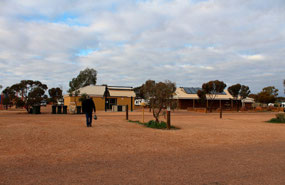
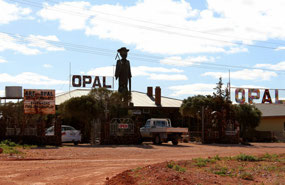
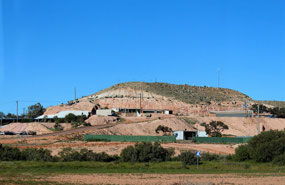
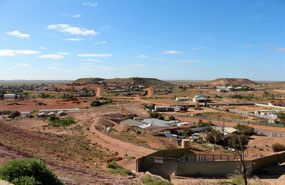
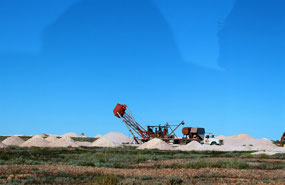
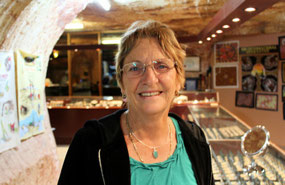
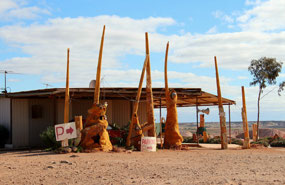
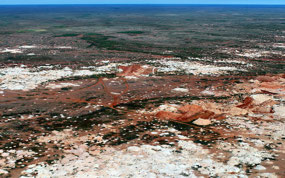
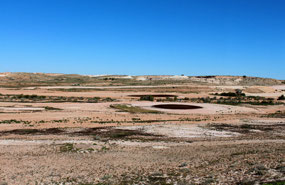
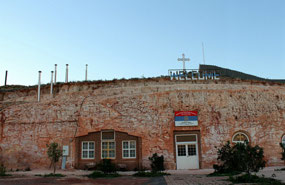

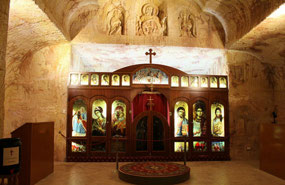
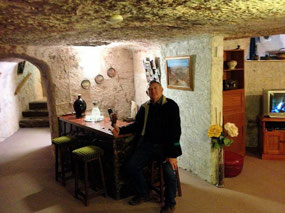
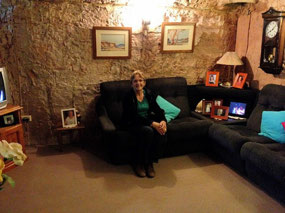
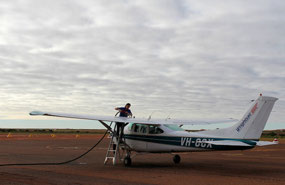
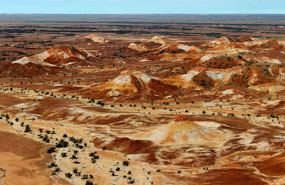
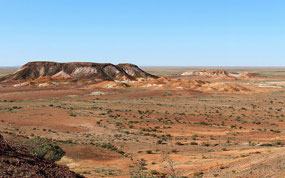
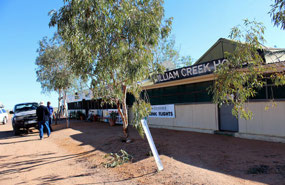
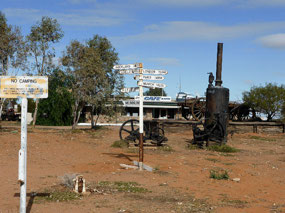
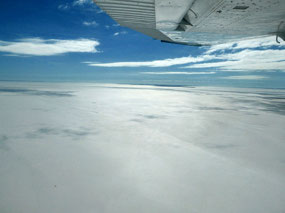
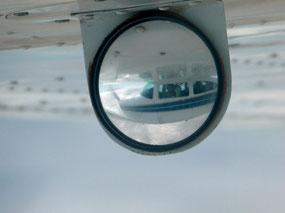
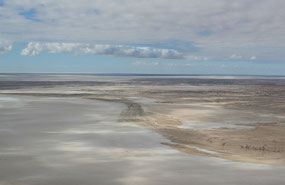
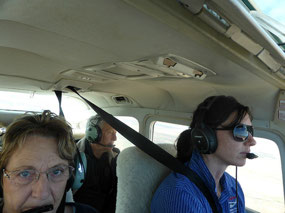
2025-05-23